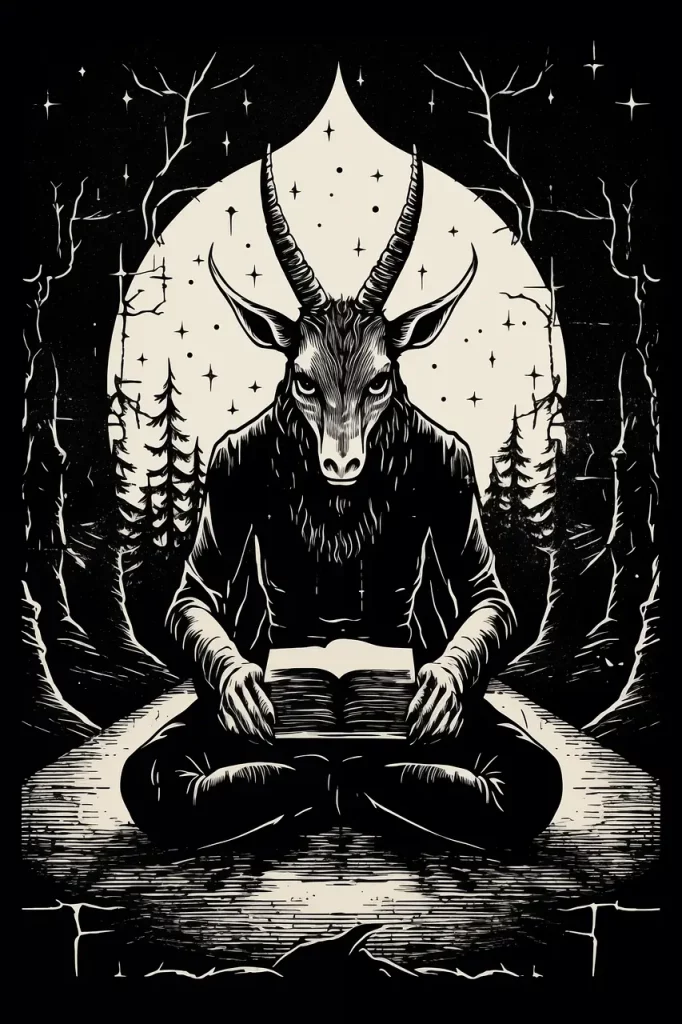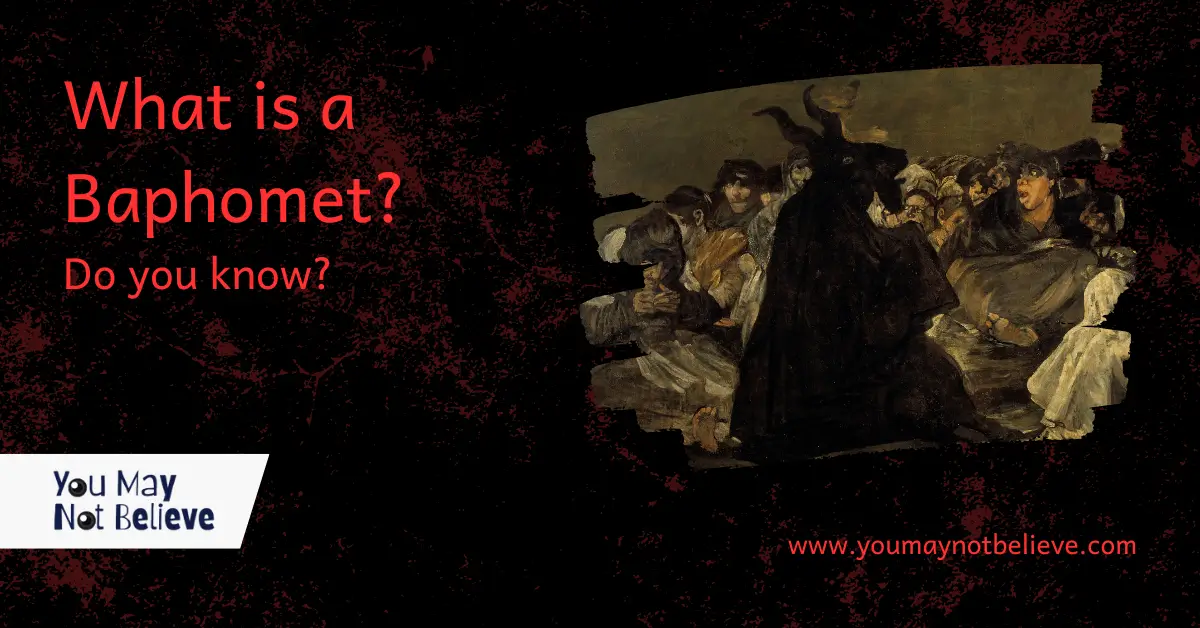What is a Baphomet? 7 Chilling Facts About The Evil Entity
Step into the mysterious world of the occult as we delve into the enigmatic entity known as the Baphomet. With origins shrouded in secrecy, the Baphomet has long been associated with esoteric practices, alchemy, and witchcraft. But what is a Baphomet, and why does it hold such fascination for many?
In this article, we unravel the history, symbolism, and significance of the Baphomet, providing you with a comprehensive understanding of this captivating figure. From its depiction in occult literature to its modern-day representations, we explore the various interpretations and meanings associated with this iconic image.
Throughout history, the Baphomet has been both revered and reviled, hailed as a symbol of spiritual enlightenment by some and condemned as a heretical idol by others. Join us as we dissect the conflicting theories and beliefs surrounding this mysterious being, shedding light on its deep-rooted cultural impact and continued relevance in contemporary society.
Whether you’re a seasoned occult enthusiast or simply curious about the secrets of the Baphomet, this article is your guide to unlocking the hidden truths behind this intriguing figure. Get ready to journey into the realms of the unknown with us as we explore the captivating world of the Baphomet.
The Origin and History of the Baphomet
The origins of the Baphomet can be traced back to the medieval period, where it was believed to be an idol worshipped by the secretive Knights Templar. The name “Baphomet” itself is believed to be a corruption of the term “Mahomet,” which was used as a derogatory name for the Prophet Muhammad during the Crusades. However, the true nature and purpose of the Baphomet idol remains a subject of debate and speculation.
One theory suggests that the Baphomet was a representation of the pagan deity Pan, who was associated with fertility, nature, and the wild. The amalgamation of human and animal features in the Baphomet’s form symbolized the union of opposites and the harmony of the natural world. Others believe that the Baphomet was a symbol of spiritual enlightenment and esoteric knowledge, representing the attainment of divine wisdom.
During the Inquisition, the Baphomet was demonized and associated with Satanism and black magic. Accusations of the Templars worshipping the Baphomet were used as a means to discredit and persecute the order. Despite this, the Baphomet continued to capture the imagination of occultists and esoteric practitioners throughout the centuries, becoming a potent symbol of mysticism and hidden knowledge.
What is a Baphomet? Symbolism and Meaning
The Baphomet is a complex symbol, rich in esoteric meaning and symbolism. One of the most prominent features of the Baphomet is its androgynous nature, with both male and female attributes. This duality represents the union of opposites and the balance of masculine and feminine energies within oneself. It embodies the idea of harmony and the integration of all aspects of the self.
The Baphomet is often depicted as a hermaphroditic figure with the head of a goat, the wings of a bat, the body of a human, and the hooves of a goat. These animalistic features symbolize the primal instincts and desires that reside within each individual. The goat’s head is also associated with the occult concept of the “Goat of Mendes,” which represents the hidden knowledge and spiritual enlightenment sought by occultists.
In addition to its physical attributes, the Baphomet is adorned with various symbolic elements. The caduceus, a staff entwined with serpents, represents wisdom, healing, and the union of opposites. The torch held in the Baphomet’s right hand symbolizes illumination and enlightenment. The pentagram, a five-pointed star, is often depicted on Baphomet’s forehead, representing the five elements and the spiritual connection to the divine.
What is a Baphomet? Misconceptions and Controversies
Over the years, the Baphomet has garnered its fair share of misconceptions and controversies. Due to its association with the occult and Satanism, the Baphomet is often misunderstood and misrepresented. It is important to note that the Baphomet is not inherently evil or demonic. Its meaning and symbolism have been distorted by those who seek to vilify and demonize occult practices.
One of the most significant controversies surrounding the Baphomet is its association with Satanism. While it is true that some branches of Satanism incorporate the Baphomet into their rituals and beliefs, it is essential to understand that Satanism is a diverse and multifaceted belief system. The Baphomet, in this context, represents individualism, personal freedom, and the rejection of oppressive societal norms.
Another misconception is that the Baphomet is solely associated with black magic and malevolent practices. While the Baphomet does have ties to esoteric knowledge and occult traditions, it is not inherently harmful. Like any symbol, its meaning is subjective and can vary depending on the beliefs and intentions of the individual.
Baphomet in Popular Culture and Media
The Baphomet has made numerous appearances in popular culture and media, often portrayed in a sensationalized and distorted manner. From horror movies to heavy metal album covers, the Baphomet has become an iconic symbol associated with darkness, rebellion, and the macabre. However, it is important to separate the fictional representations from the true essence and meaning of the Baphomet.
In literature, the Baphomet has been featured in various occult and esoteric texts, such as Eliphas Levi’s “Dogme et Rituel de la Haute Magie.” Levi’s depiction of the Baphomet as a hermaphroditic figure with various symbolic elements became the foundation for many subsequent interpretations of the Baphomet.
In recent years, the Baphomet has also been thrust into the spotlight due to legal battles surrounding its use in public spaces. The Satanic Temple, a religious organization that uses the Baphomet as its symbol, has fought for the right to display Baphomet statues alongside other religious monuments in public spaces, arguing for religious plurality and freedom of expression.
The Influence of the Baphomet on Occult Practices
The Baphomet has had a significant influence on occult practices and esoteric traditions. It is often used as a focal point for rituals and ceremonies, representing the attainment of spiritual enlightenment and the integration of opposing forces. The Baphomet is seen as a guide and teacher, offering wisdom and knowledge to those who seek it.
In various magical systems, the Baphomet is invoked as a source of power and transformation. It is believed that by working with the Baphomet, individuals can tap into their hidden potential and awaken their spiritual senses. The Baphomet serves as a symbol of personal growth and the journey towards self-realization.
Baphomet as a Religious Symbol

For some, the Baphomet is not just a symbol of occult practices but also a religious symbol. The Satanic Temple, mentioned earlier, views the Baphomet as a representation of their beliefs and values. They see the Baphomet as a symbol of individualism, equality, and the rejection of arbitrary authority.
The Baphomet’s association with religious pluralism and freedom of expression has sparked debates and controversies. Some argue that Baphomet’s presence in public spaces undermines traditional religious values, while others advocate for the recognition of diverse religious beliefs and practices.
Regardless of one’s stance on the matter, the Baphomet’s status as a religious symbol highlights the complexity and diversity of religious beliefs in contemporary society.
The Baphomet and Its Connection to Secret Societies
The Baphomet has long been associated with secret societies and fraternities, adding to its air of mystique and intrigue. Some speculate that the Baphomet was a secret symbol used by the Knights Templar to represent their esoteric knowledge and spiritual pursuits.
In modern times, the Baphomet has been linked to various secret societies, such as the Freemasons and the Ordo Templi Orientis (OTO). These organizations incorporate the Baphomet into their rituals and teachings, associating it with enlightenment, self-discovery, and the pursuit of hidden truths.
The exact nature of the Baphomet’s connection to these secret societies remains a subject of speculation, with much of their true practices and teachings shrouded in secrecy.
Baphomet Statues and Artwork
Various statues and artwork depicting the Baphomet have been created throughout history. These representations range from classical depictions inspired by Eliphas Levi’s writings to modern interpretations influenced by popular culture.
One of the most well-known Baphomet statues is the one commissioned by the Satanic Temple. This bronze statue, featuring an androgynous figure seated on a throne, has garnered significant attention and controversy due to its attempts to challenge the dominance of religious symbols in public spaces.
Baphomet-inspired artwork can be found in various forms, including paintings, illustrations, and sculptures. Artists often explore the multifaceted nature of the Baphomet, using it as a symbol to convey their own interpretations and beliefs.
Baphomet in Modern Witchcraft and Paganism
In modern witchcraft and pagan traditions, the Baphomet has found a place as a symbol of personal empowerment, spiritual exploration, and the celebration of nature. Some witches and pagans incorporate the Baphomet into their rituals and practices, viewing it as a representation of the divine within themselves and all living beings.
The Baphomet’s associations with duality, balance, and the integration of opposites align with many witchcraft and pagan beliefs. It is seen as a guide and ally, providing insight and wisdom on the path of self-discovery and spiritual growth.
Is it possible to call Baphomet to execute an evil act?
There’s no basis in reality for summoning Baphomet to do your bidding. Here’s why:
- Uncertain Origins: The historical existence and nature of Baphomet are unclear. It wasn’t a worshipped idol by the Knights Templar as accused, and its true meaning is debated.
- Symbolic Figure: In occult traditions, Baphomet represents concepts like duality or rebellion, not a being to command.
- Fictional Portrayals: Many portrayals of demonic summoning come from fiction, not real-world practices.
Facts & beliefs about Baphomet
- Mysterious Origins: Baphomet’s first documented mention is in 1098, possibly referring to a Muslim deity like Muhammad, not a specific idol. Its true origins and meaning remain debated by scholars.
- Knights Templar Accusation: The most infamous link is to the Knights Templar. In the 14th century, King Philip IV of France accused them of heresy, including worshipping Baphomet, likely as a ploy to seize their wealth.
- Symbol, Not Deity: Baphomet isn’t traditionally worshipped as a god. It gained traction as a symbol in occult circles, often representing duality, balance, or rebellion against religious norms.
- Evolving Image: There’s no fixed appearance for Baphomet. The influential image of a goat-headed figure with male and female features comes from Eliphas Levi, a 19th-century occultist.
- Modern Influence: Baphomet’s image is used by some Satanic groups and became a pop-culture symbol, though its historical connection to Satanism is tenuous.
Conclusion: Understanding What is a Baphomet?
The Baphomet is a symbol that encompasses a rich tapestry of history, symbolism, and meaning. From its mysterious origins to its contemporary representations, the Baphomet has captivated the imagination of many throughout the ages. It has been both revered and reviled, celebrated and condemned.
Understanding the complexity of the Baphomet requires a willingness to explore beyond the surface-level misconceptions and controversies. It calls for an open mind and a willingness to embrace the diversity of beliefs and practices that surround this enigmatic figure.
Whether viewed as a symbol of spiritual enlightenment, a representation of hidden knowledge, or a religious icon, the Baphomet continues to hold a fascination for those seeking deeper meaning and a connection to the unknown. It serves as a reminder of the vastness and complexity of the human experience, inviting us to explore the realms of the occult and uncover the hidden truths that lie within.

You wish to meet a smart freaky blogger who loves exploring myths, superstitions, and facts. That’s me. A Digital Marketer, blogger & cook. All of the above.

